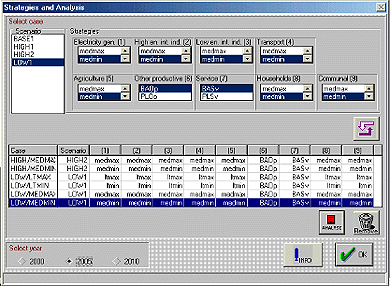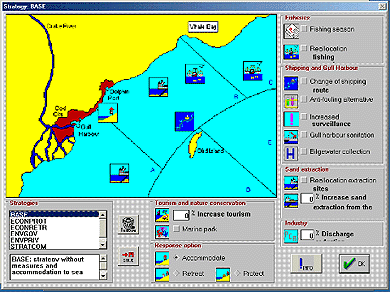After the investigation and definition phase, a number of (perhaps new) alternatives are listed and investigated. The most promising alternatives are then selected to tackle the issue. It is important that relevant pieces of information should be brought together, compared and considered in relation to each other.
To achieve this, however, equivalent and comparable aggregate information needs to be available on each alternative. The emphasis is on 'where?' and 'what?'.
Decision Support System is a term used to refer to tools that are specifically designed to assist policy makers in the decision process. A DSS should at least contain -or be able to access- the following elements:
- information elements that handle the information about the system:
- databases; containing factual information, historical and present information about the system
- numerical models; generating new information about the system
- application tools; presenting and comparing information in different formats, depending on policy requirements
- interface elements that help the user to access and manipulate the information elements:
- presentation of information
- guidance from question to answer
Designing DSS's for ICZM must be done taking into account that the decisions are made under larger uncertainty, due to time scale and system-complexity. DSS's are required that can deal with longer time scales and larger uncertainties. Analysis can often only be done, and is as well often only necessary, at a "scoping and screening" level. Decision makers on a planning level usually only need these type of results. Detailed deterministic modelling becomes inappropriate and time-consuming, but they are necessary to provide insight in the various processes (physical, ecological, socio-economical, institutional etc.). The insight and/or parameters and/or trends that are derived in that way are used in other modelling concepts that give results instantly (like linear approximation, analytical modelling based on quasi-steady states or fuzzy modelling). Results can have a forecasting character (impact assessment) or the character of presentation of 'state of the system' (using concepts above to derive values for the selected indicator for decision-making out of available data).
The DSS can never incorporate all issues. Comprehensiveness must be weighed against accuracy, when inclusion of more issues leads to more uncertainty on the effect-calculation and a more difficult evaluation process. Selection of issues should be based on contact with as many stakeholders as possible. In a later stage of the ICZM process issues can be added (again). The design of a ICZM-DSS is, hence, also cyclic.
The issue 'Coastal Zones' determines the type of questions that the DSS will have to answer. Consequently it limits the scope of the databases, models and tools, as well as (the design of) the interface.
To build a functional DSS, the model developer has to ensure that the two elements, which were mentioned above, meet:
- the information elements, i.e. the 'supplying' or 'bottom-up' part. This is the inventory and making available of data and models
- the user-supporting part, i.e. the 'question' side or 'top-down' part. This requires a thorough inventory of the type of questions that the DSS has to answer. On the basis of a study of the decision making process
The emphasis is on policy development and consensus building. Characteristics and applications are:
- showing data in interaction with users perception
- relations with simulation model
- designed for supporting participatory policy making processes
- educational tools
Some examples of these tools are:
|

Figure 3-4 This Decision Support System helps you to build scenarios and compare there consequences. To do so the DSS is based on a large database

Figure 3-5 COSMO-BIO is a DSS specifically designed for Coastal Zone Management
|